Bamboo shoot is a much loved delicacy of the monsoon season. Though most varieties of bamboo have edible shoots, the two most commonly eaten in Coorg are the newly emergent culms of the Spiny or Thorny Bamboo (Bambusa bambos/ B. arundinacea) and the slender, asparagus like Ochlandra scriptoria/O.rheedii, known locally as watté baimbalé.
This season’s supply of the mullu baimbalé (thorny bamboo) has been badly hit, thanks to the flowering that happened earlier this year*.
Beginning in late May, emerging culms are harvested and the sliced shoots are processed by soaking in plenty of fresh water for 24 hours. This serves to leach out much of the hydrocyanic acid present in some varieties of bamboo. The rest is probably dissipated in the cooking process. In the picture below, you’ll see some bubbles in the water the sliced bamboo has just gone into. This frothing is instantaneous and, by the following day, you’ll see a lot more of it. There’s also a very distinctive fragrance to it – the scent of danger, perhaps?!
The water is changed and the shoots are once again soaked for 24 hours in just enough fresh water to cover them. The long soaking begins a process of light fermentation that gives the bamboo a slight but very appealing tang. The water from the second soaking can be used to cook the bamboo shoot. Prepared shoots are eaten in curries and stir-fries, turned into spicy pickles or preserved in brine for later use. Nowadays freezing is an easy and effective option. My mother usually has a stash of parboiled, frozen bamboo shoot to last her until the next monsoon!
* For me, the only good thing to come of this,was finding out firsthand about some of the “also rans” in the bamboo hierarchy- not too bad, some of them! Oh, and also some bamboo rice.
Baimbalé curry
- ½ kg thinly sliced bamboo shoot
(if the bamboo is very tender, you can cook it directly into the curry. Otherwise, it is usually parboiled before use with a little turmeric and salt and using the sour soaking water.)
- 2 medium onions, finely sliced
- 5-6 cloves garlic, lightly crushed
- A small sprig of curry leaves
- ½ tsp mustard seed
- 2-3 dry red chillis,
- ½ tsp turmeric
- 1 tbsp ground coriander
- 1/2 tsp chilli powder, or to taste
- 1 ½ cups grated coconut, ground to smooth paste.
- 1 tsp dark jaggery (optional)
- A dash of kachampuli** or ½ tsp thick tamarind extract
- 2-3 tbsp oil.
Grind together:
- 1/2 tbsp dark roasted cumin
- 1 tsp roasted mustard seed
Heat the oil on a deep pan, kadhai or wok and put in the mustard. When it sputters, put in the red chillis, curry leaves and garlic. Sauté briefly, then add the onions and cook until they are soft and beginning to brown.
Put in the bamboo shoot, all the remaining spices and 2 cups of hot water. Bring to a low boil and then simmer for 10-15 minutes, or until the bamboo is tender but still firm to the touch.
Add the jaggery if using, followed by the ground coconut paste and simmer for a few minutes more. Stir in kachampuli or tamarind two minutes before removing from the heat.
A perfect pairing with akki ottis and a touch of ghee.
** a souring agent made from the fruit of Garcinia gummi-gutta.

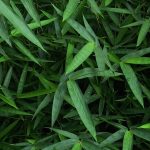
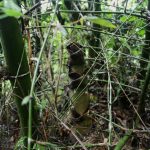
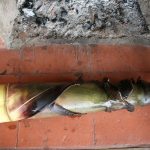
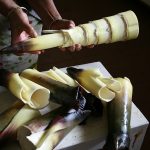
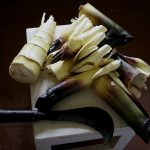
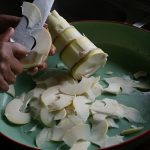
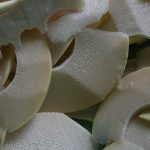

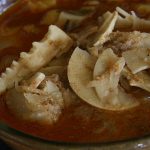
Shalini,
I have a question about the fatter Bamboo, Bambusa b. perhaps? The photo shows the outer leaf-like sheaths protecting the inner shoot. Is the skin of these sheaths covered with ordered ranks of black hairs/trichomes, from top to bottom? I can see some dark zones, but not if they have sharp hairs.
On the shoots of Dendrocalamus strictus in Bengal, these protective trichomes are amazingly recalcitrant AND cruel to the skin & respiratory tract. The shoot has a very powerful “Bamboo shoot” flavor, possibly the hydrocyanic acid you mention, and are bitter. Blanching is a must, but this strong “bamboo” flavor & some residual bitterness is much appreciated. An interesting oil pickle is made, besides curries with shrimp & duck.
Rattan Palms & their fruits: since rattan is used somewhat like bamboo, I am putting my question here. Coorg might be rich in Rattan palms of several species, and they could have edible fruit, as they have elsewhere. Is there a tradition of gathering this interesting forest product?
Gautam,
The sheaths generally do have those hairs on them but maybe not so pronounced as you describe. The bamboo in the picture was a particularly rain-soaked specimen from a youngish bamboo (in the backyard as it happens) and as tender as I’ve ever seen, with hairs only on the tips. The colouring reminded me of the inner leaves of an artichoke.
There is no bitterness, but something of that peculiar fragrance remains from the soaking water.
I’m told the British banned the export of rattan from Coorg at one time because it was overexploited for commercial purposes. Besides being worked into baskets and small pieces of furniture, cane is used for making the strikers of certain ceremonial drums. Lengths of cane are used in several dances of the menfolk. The tender shoots are one of the ingredients in an offering prepared during the harvest festival. I don’t know about the fruit.Of course, every home had a “thura kol” or cane switch handy for er..maintaining discipline.:-)
Thanks for all the info. Since the bamboo & cane seem to be so tender & innocuous, my comment should read: JUST EATS! Ha, I kill myself!!
But, anyway, I will keep agitating for Coorg to be declared a special Floristic [& Faunal] Refugia, similar to the Cape & Table Mountain. The UN should declare it as such. Just as they have declared the RAMSAR Wetland Sites, so too this area of tropical wetlands & the source of the Kaveri, which nourished 2 states, needs to be strictly protected. I.e. the Earth Sponge of various understory, overstory layers & forest floor humus needs to be preserved as is. Indian ideas of development, even well-intentioned tourist spas, or the expansion of plantations, are both inimical to the ancient mosaic of cultivated & wild lands.
We need to preserve whatever patches of true forest & woodlands we have left, especially the rich diversity of the humid tropics. This is far from a luxury. The germplasm of major fruit species, many plants, but also important soil fungi, insects, bacteria, and medicinals lie hidden in such undisturbed habitats.
It might be worth trying to set up knowledge-based industries to solve income & growth issues. These might leave a lighter, gentler footprint on this unique ecology, both natural & human.
https://www.youtube.com/watch?v=NUAvdYNGTQU&list=PLxHSKe-bOElxrr_pnKs7itdE7aEa_M68W&ab_channel=visa2explore
look at the comments section!!!